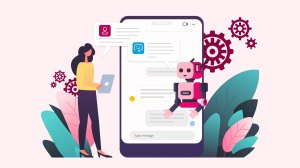Everything You Need to Know About AI in Customer Service

How can you do more with less in customer service? The answer is AI. Here’s what you need to know to set up for success.
Table of contents
- What is AI in customer service?
- What are the benefits of AI in customer service?
- 8 examples of AI in customer service
- How to use AI to improve customer service
- 3 things to consider when implementing AI in customer service
- The future of AI in customer service
- How to get started with AI in customer service
If you asked any customer service professional to describe how the last few years have been, they’d probably say “intense.” With budgets in flux and customers expecting more, service teams are constantly figuring out how to answer an important question: how do you actually do more with less? The answer is AI in customer service.
Since the pandemic, customer service has been a rollercoaster ride. Customer expectations are higher than ever — 72% of consumers say they will remain loyal to companies that provide faster service. And 78% of service agents say it’s difficult to balance speed and quality, up from 63% since 2020. All of these pressures have led to a turnover rate of 19% in service organisations.
While predictive AI is not new to customer service, generative AI has stepped into the spotlight just a year ago. With the powerful potential of this new technology, business leaders need a generative AI strategy, while remaining mindful of budgets. And service professionals and customers alike are curious how AI-powered customer service will impact their experience. Let’s dive into what AI does, its benefits, and how you can get started.
Put AI, automation, and data to work
The right mix of customer service channels and AI tools can help you become more efficient and improve customer satisfaction. Our guide reveals how high-performing service orgs make it happen.



What is AI in customer service?
There are many different ways you can use AI in customer service. For example, you can embed AI-powered chatbots across channels to instantly streamline the customer service experience. Beyond answering common questions, these chatbots can greet your customers, serve up knowledge base articles, guide them through common business processes, can send out a field technician for field requests, and can route more complex questions to the right person.
Imagine this from the customer perspective: you want to return a pair of shoes and you need some help. You start an online chat with an agent, but then wait 30 minutes for a response.
With customer service AI, you get a personalised response in seconds. Think of it like a virtual buddy who’s not only knowledgeable, but also understands your exact needs and preferences. All you have to do is tell it what you need help with, and it will take care of the rest. No need to find your tracking number, provide your email, or explain the details of your purchase, it already has all that information and knows exactly what to do.
So many organizations are already using AI for customer service. In fact, the share of service decision makers who report using AI has increased by 88% since 2020 — up to 45% from 24%.
What are the benefits of AI in customer service?
Let’s look at six ways AI in customer service can help your team, especially if you’re interested in getting started with generative AI:
- Higher productivity: An AI tool like Einstein Copilot can empower service teams to get work done faster — for example, AI can act as an assistant built directly in an agent’s flow of work. In fact, recent research shows that 84% of IT leaders believe AI will help their organisation better serve customers. Case in point: AI-based conversational assistants can increase productivity by 14% for support agents.
- Better efficiency: Manual processes can be a heavy lift for service agents. This includes tasks like swivelling back and forth between systems and screens to view customer history, searching for knowledge articles, routing field workers to service locations, and manually typing responses — all of which tend to be error-prone when done by a human. AI in customer service can give customer service workers intelligent recommendations across knowledge bases, conversational insights, and customer data. Our recent research found that 63% of service professionals say AI will help them serve their customers faster.
- A more personalised service interaction: For AI to be useful, it needs to understand your customer, which means it needs access to your company’s data. When a customer initiates a conversation with a chatbot, AI can populate important information — such as the customer’s name, location, account type, and preferred language in real time. If the request requires a field service technician, AI can send all of the important information to the field worker so they can provide personalised service the moment they walk in the door.
- Optimised operations: AI in customer service makes customer service operations smoother and more efficient. You can use AI to analyse customer calls, emails, and chatbot conversations to determine the signs that a customer is likely to escalate an issue, the time it will take to resolve an issue, and more. These insights help find new ways to improve the customer experience. For example, if customers often ask for an agent when they want to return a product, a chatbot can proactively share a knowledge base article to minimise escalation.
AI can also analyse your company’s case history and identify the top reasons your customers contact customer service. If a knowledge article doesn’t exist to address one of these reasons, you can use generative AI to draft a knowledge article or update an existing one. Once your team approves the article, it then helps agents to provide quick and exceptional support and can be used to deflect cases in a self-service portal or with a chatbot. - Less burnout and improved morale: AI allows agents to eliminate repetitive, time-consuming work and focus on situations that require creative problem solving, social intelligence, and complex critical thinking — activities that will move the needle on overall customer experience. It’s not a surprise that 79% of IT leaders say generative AI will help reduce team workload and thereby reduce burnout.
- A proactive service experience: AI can draw info from your customers’ contracts, warranties, purchase history, and marketing data to surface the next best actions for agents to take with your customers — even after the service engagement is over. For instance, AI can let customers know that it’s almost time to renew their subscription, remind them when it’s time to book a maintenance appointment, or that a product upgrade or discount is available. And taking that to the next level, generative AI can even summarise customer conversations and produce knowledge base articles for future reference.
8 examples of AI in customer service
Whether you’re in the contact centre or in the field, AI in customer service can transform the customer experience. Here are a few examples:
1. Content Generation: Generative AI can analyse customer conversations, extract relevant details, and generate human-like replies to customer questions, improving response times and overall customer satisfaction. This is especially true when the AI pulls from CRM data and knowledge.
2. Chatbots: AI-powered chatbots can handle basic customer inquiries, provide instant responses, and assist with tasks such as order tracking, product recommendations, and troubleshooting. They are available 24/7, reducing response times and improving customer service accessibility.
3. Natural Language Processing (NLP): NLP is a technology that enables AI systems to understand and interpret human language. It helps in analysing customer sentiment, identifying customer needs, and providing relevant responses. NLP can also facilitate unstructured search — which allows systems to understand and respond to more flexible and conversational queries (versus a structured keyword search). This capability enhances the effectiveness of chatbots, voice assistants, and sentiment analysis tools. This helps businesses provide a more intuitive and personalised customer experience.
4. Sentiment Analysis: AI-powered sentiment analysis tools monitor and analyse customer feedback, reviews, and social media interactions to gauge customer sentiment. This helps companies identify areas of improvement, respond to customer concerns, and provide personalised experiences based on customer preferences.
5. Recommendation Systems: AI-driven recommendation systems analyse customer behaviour, purchase history, and preferences to provide personalised product or content recommendations. By understanding individual customer preferences, companies can enhance cross-selling and upselling opportunities.
6. Predictive Analytics: AI-based predictive analytics uses customer data to anticipate customer needs, behaviour patterns, and potential issues. This helps companies proactively address customer concerns, optimise resource allocation, and personalise customer interactions.
7. Self-Service Solutions: AI-powered self-service solutions, such as knowledge bases or FAQs, leverage natural language processing to understand customer queries and provide relevant information or troubleshooting steps. This allows customers and agents to find answers quickly without requiring human assistance.
8. Intelligent Routing: AI-based intelligent routing systems analyse incoming customer inquiries and route them to the service representative or department with the most relevant experience or knowledge. This ensures that customers are connected to the right person who can address their needs efficiently.
How to use generative AI to improve customer service
Here are a few ways that AI can help organisations provide even better service to their customers:
Increase productivity by acting as a trusted assistant: With a generative AI tool like Einstein Copilot, agents can quickly generate personalised replies to service inquiries. And the generated responses aren’t one-size-fits all: AI can create trusted, natural language responses based on relevant customer data, knowledge articles, or trusted third-party data sources on any channel.
Create work summaries and mobile work briefings: Customer service AI can drive agent productivity by automating the time-consuming but crucial task of writing wrap-up summaries based on case data and history. This is especially helpful in the field. You can summarise the most relevant data to start the job — saving your frontline workers time.
Preserve and share knowledge across your business: You can connect a generative AI tool to your service console and have it create the first draft of your knowledge base article based on conversation details and CRM data for your experienced agents to review. This will save you time and help you get your articles out faster. An extra bonus: you can also use these knowledge base articles to help customers find their own answers to questions in a self-service portal.
Search for answers: As your agents or customers are looking for answers to a question, AI in customer service can surface a generated answer from your knowledge base, directly into the search page — saving everyone time.
3 things to consider when implementing AI in customer service
Despite the benefits of AI in customer service, there’s still a ways to go in terms of adoption. According to recent research, less than half (45%) of service decision-makers told us they’re using AI. So what’s holding organisations back?
1. Impact on the workforce: Since AI, especially generative AI, is a new field, service leaders are struggling with a skill gap. For example, 66% of leaders believe that their team doesn’t have the skills needed to handle AI. And similarly, service professionals are concerned that AI could take over their jobs, which can make them apprehensive about embracing the technology. As you bring AI into your service organisation, communicate how AI will help your teams get more done and that their human-skills are still very much needed to provide a great experience for your customers.
2. Trust and reliability issues: AI technology, although rapidly advancing, is not perfect. For one, most learning language models are trained on data that’s almost two years old. Similarly, there may be concerns about the accuracy of AI systems in understanding and resolving complex customer queries or handling sensitive information. Similarly, concerns around privacy and trust should be taken seriously — and must be managed carefully to keep your business and customer data secure. When the data for AI is grounded in your trusted CRM data and knowledge base, you can solve this challenge.
3. Investment and implementation: Depending on whether or not you decide to develop your own AI or bring in customer service software that includes AI, it may require significant investment in technology infrastructure and training. Small businesses or organisations with limited resources may find it difficult to fund AI implementations or lack the technical expertise to deploy and maintain such systems.
The future of AI in customer service
As AI in customer service rapidly evolves, more use cases will continue to gain traction. For example, generative AI will move from the contact centre into the field. This technology will ensure frontline field service teams have the right customer, asset, and service history data for the job at hand. Through AI in customer service, field service teams will offload more of the mundane work — through automated work summaries, knowledge articles, and more.
How to get started with AI in customer service
AI in customer service doesn’t have to be difficult to understand — or implement. The first step is learning more about what it can do for your business.
Begin by learning more about how generative AI can personalise every customer experience, boost agent efficiency, and much more. Then check out how you can make the most of AI in customer service.
Then you can start small. For example, deploy an AI assistant using a set of standard actions (like find, summarise and update records or answer questions using knowledge articles inside Salesforce) that pull from data that already exists in Salesforce.
You can then extend Copilot to fit your business needs with Copilot Studio. Here, you can build and deploy custom actions using existing flows and apex code. Actions can be customised using technology that you already have with Salesforce.
Power your customer service with generative AI
You can scale your customer service with the power of generative AI, paired with your customer data and CRM. See how this technology improves efficiency in the contact centre and increases customer loyalty.

























